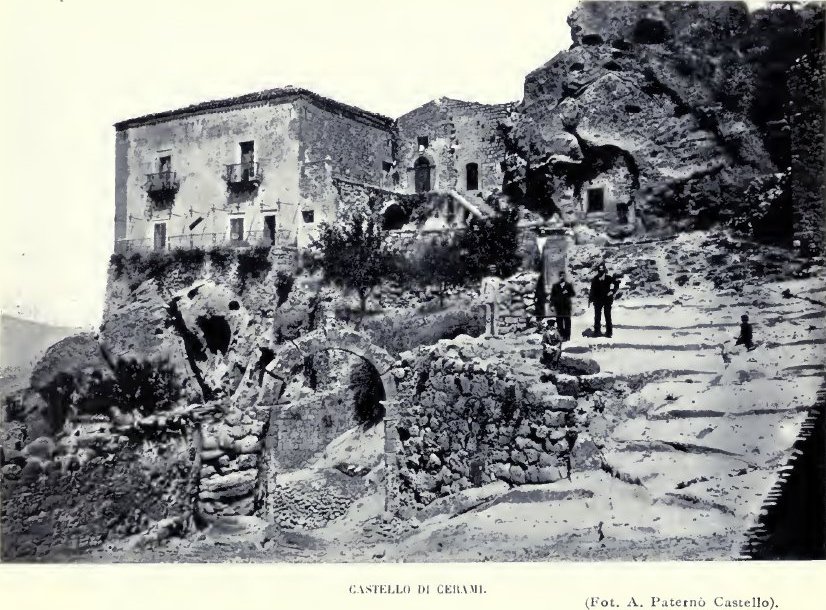Cerami

Cerami has the feel of a rectangular Byzantine structure, yet, unlike
so many other sites discussed under Aci,
no such origin is attributed to this site, despite their being hypogeum
in the rocks that dominate the site. The history of the
castle begins in 1063 when a standoff occurred for 3 days along the
River Cerami. Here a heavily outnumbered Count Roger Hauteville
(d.1101) faced the Africans and the Arabs with their
Sicilians. The action ended when the Arabs crossed the river
and occupied the castle. At this Count Roger fell back on
Triona, but on the fourth day Hauteville (d.1072), the nephew of
the count, with just 36 men assaulted and took the castle, allegedly
putting to flight some 3,000 of the enemy. With this Count
Roger returned and a fought a battle against the Saracens in which St
George is said to have ridden with the Normans and 15,000 of their
enemies fell. After gaining the victory the castle was
entrusted to by his Uncle Roger and in August 1072 he was
recorded as lord of that place. While was at Enna he
was brought news that the Saracens had attacked Cerami and sacked
it. Impulsively marched after the enemy, but was met
and killed, his men defeated and his body beheaded as an act of triumph
by the enemy. This happened after a one sided battle between
Cerami and Nicosia.
Cerami castle, if it fell in 1072, was soon regained and in
1082 it was recorded as within the diocese of Troina. In the
1154 Book of Roger, Edrisi described the place as a prosperous hamlet
overlooked by a high fortress. This certainly still describes
the site today. By 1157 the castle had been subinfeudated to
Henry Aleramico. Thirteen years later in 1170 the fortress
was under the command of a castellan called Bernard. With
this the castle fades into obscurity, although in 1296 it was recorded
that Peter Antioch (a grandson of Frederick
II) held 2 parts of Cerami. The castle appears to
have continued in existence being mentioned in 1308/10 and
1366. Finally the castle passed to William Rosso in 1396 and
remained with that family until the end of feudalism in 1812.
Description
The crag of Cerami castle, 3,450' high, dominates the region and has views to Gagliano,
Agira, Capizzi, Nicosia and in the distance even Assoro and
Enna. It is now rather disappointing as
most traces of the castle are gone and the site is disfigured by a
water works. The actual castle rock is punctured by various
hypogeums and surrounded by the meagre fortress remains. These
consist of fragments of the local stone mortared into position along
the sides of the cliff. Vague traces of rectangular structures
can be made out to the northwest and to the southeast are the remnants of a curtain
with 4 internal rectangular chambers. Before 1907 a Romanesque
gateway stood to the southeast which allowed entrance to the fortress.
Behind this lay the mid seventeenth century palace of the Russos and
the church of St Georgio.
Why not join me at other Sicilian
castles? Information on this and other tours can be found at Scholarly
Sojourns.
Copyright©2019
Paul Martin Remfry

